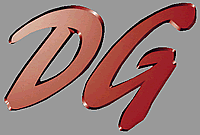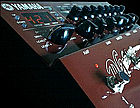| |
| INTRODUCTION |
 |
 |
At
the end of the '90s, many guitar players decided to use traditional
tube amplifiers and analog pedals refusing the digital processors,
racks and MIDI programmable pedalboards used during the '80 and
'90 years. The majority of the guitar players wasn't probably looking
for a wide range of tonal possibilities: a good amplifier connected
to an high quality pedal could provide few but great sounds not
available in a digital system. When this trend seemed to be consolidated,
new guitar digital systems have been introduced, providing a wide
range of realistic sounds generated by the physical modeling technology.
In fact, the sounds, generated by mathematic algorithms, were reproducing
a realistic tube tone and the built-in knobs (very similar to an
amplifier controls) allow a real-time and familiar sound shaping.
Yamaha has been one the first manufacturers that introduced in the
market the amplifiers simulation based on the ECM (Electric Circuit
Modeling) technology. The know-how developed in digital mixing consoles
applications and the physical modeling technology built in the early
90's VL series synthesizers have been the first important step in
this direction. After the introduction of the DG pre-amplifier and
amplifier series (a real breakthrough in matching guitars and digital
processors), Yamaha now manufactures a versatile pre-amplifier providing
overcoming features: the DG-Stomp.
 Functions
and Controls Functions
and Controls
 Rear
Panel Rear
Panel
 DG
Amplifiers DG
Amplifiers
 Technical
Details Technical
Details
|
| MAIN
PLUS |
 |
| |
Convenience.
An intuitive operativity and an immediate sound control are the
DG -Stomp more significant features: all parameters can be selected
thru dedicated knobs or buttons. No motorized controls are available
as in the Yamaha amplifiers DG series. Nevertheless, the DG-Stomp
clearly displays all parameters available for user-friendly editing.
The Manual mode provides quick operativity and programming, including
an easy way to save data into the selected memories.
Flexibility. The DG-Stomp is a very flexible unit. A wide range
of knobs is available, for effective studio applications. On the
other hand, the sturdy structure and the pedals suggest a live use,
during performances in which a compact size, easy-to-carry and fully-equipped
unit is required. The speaker simulator allows global or individual
Program settings, depending from the possible path of the output
signal (direct connection to the mixer or to power unit and speakers).
Moreover , the preamplifier section can be switched off in order
to use the DG-Stomp as an effect processor, connected to external
amplifiers or pedals.
Memories
and MIDI control. The DG-Stomp provides two areas: Preset and
User. Each area includes 10 Groups, each one providing 3 Banks.
Each Bank includes 3 Patches. Consequently, the unit provides a
total of 90 Preset + 90 User Programs. The User area is dedicated
to the user's settings storage. In addition to the parameter settings,
a Patch can store also the assignment of external controllers to
a maximum of 8 internal parameters. A controller can act via MIDI
(or expression pedal input) as a volume pedal (pre or post preamp,
for drive control), a wha pedal (featuring frequency, resonance
and on/off switch) or as a parameter remote control (tune and effects).
Sound Quality. Just eight amplifier models can be selected.
This could mean a reduced sonic flexibility in comparison with other
similar units. On the other hand, the EQ control provides signal
processing features that largely overtakes the timbral response
of a typical guitar amplifier. There is no clear references to specific
amplifier models and brands: the DG-Stomp has been designed to simulate
the tube amplifiers characteristics and doesn't provide preset amplifiers
tones. The player that likes to program his original sound working
on the available parameters will really appreciate this feature
(the user interface is really intuitive and user-friendly). The
effect section also doesn't reproduce specific models, but provides
a versatile array of fully programmable effects. The sound is warmth
and realistic, but, sometimes, the attack is too clean and aggressive
compared with the sound provided by the real tube amplifiers. Depending
on the needs, this feature can also be an useful advantage. The
"speaker simulation" section provides many choices. A strong point
is the good interaction of the simulator with the guitar speakers,
avoiding the risk to radically change the timbral characteristics
of the sound. In addition, the DG-Stomp simulations can be successfully
used to reduce the noise of the most powerful and bright guitar
speakers. This way avoids to choose between line amplification (direct
connection) and guitar amplifiers.
|
| USER
INTERFACE |
 |
| |
Editing.
Basically, the unit is user-friendly: the first step is to select
an amplifier model, in order to achieve the raw tonal elements.
Then, it' time to turn the knobs. Rotating the knobs, the display
shows a level range between 0 and 10. When the parameter is modified
the orginal value is displayed: rotating the relevant knob doesn't
edit the sound until the stored setting has been reached. This safety
mode avoids unneeded parameters editing and output signal bounces.
Pedalboard.
The built-in pedalboard selects the Bank memories. It enables also
the tuner function and allows a direct setting of the delay time
thru the "tap" facility, without acting on the front panel. An optional
pedal can simultaneously control up to eight parameters, depending
on the program settings. Finally, the wah on/off point can be conveniently
set along the pedal range for an instinctively familiar approach.
|
|
CONCLUSIONS
|
 |
|
|
The DG-Stomp is a hybrid machine that can be easily connected both
to a mixer or to an amplifier. Compared with other units, the DG-Stomp
provides a restricted number of amplifiers simulations. On the other
hand, tune and effects control is very flexible and allows a tailored
sound creation. The real time control, that has been a big disadvantage
in the first Yamaha DG amplifiers series, is now the main strong point
in this unit. Flexibility and intuitive operativity are the main advantages
that should be pointed out both for studio recording and live applications
as well as the interesting quality/price ratio. |
|
 |



